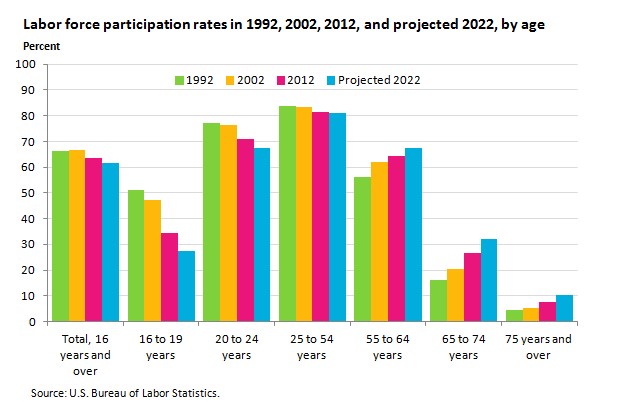 Workers aged 65 years and older are continuing to participate in the workforce past retirement age in greater numbers. Recent projections by the Bureau of Labor Statistics show that by 2022, 31.9% of those aged 65 to 74 will still be working.
Workers aged 65 years and older are continuing to participate in the workforce past retirement age in greater numbers. Recent projections by the Bureau of Labor Statistics show that by 2022, 31.9% of those aged 65 to 74 will still be working.
Whether this is due to a desire to accumulate additional retirement savings, or to stay active and engaged with their communities, the increased aging workforce presents a few considerations for employers.
One issue employers may face is worker safety. However, the CDC notes that workers who are older tend to experience fewer workplace injuries than their younger colleagues. This decrease may be due to higher level of experience gained from longevity in the workplace, or because older workers may have higher levels of caution when performing their job duties.
It is important to note that when accidents involving older workers do occur, they can be more severe and require more time for the injured worker to heal.
This highlights the importance of having well-planned return-to-work and training programs in place.
Read on for strategies from the CDC to keep your aging workers safe.
- Match tasks to abilities. Use self-paced work, self-directed rest breaks, and less repetitive tasks.
- Avoid prolonged, sedentary work. Prolonged, sedentary work is bad for workers at every age. Consider sit/stand workstations and walking workstations for workers who traditionally sit all day. Provide onsite physical activity opportunities or connections to low-cost community options.
- Manage hazards. Including noise, slip/trip hazards, and physical hazards – conditions that can challenge an aging workforce more.
- Provide and design ergo-friendly work environments. Workstations, tools, floor surfaces, adjustable seating, better illumination where needed, and screens and surfaces with less glare.
- Utilize teams and teamwork strategies for aging-associated problem solving. Workers closest to the problem are often best equipped to find the fix.
- Provide health promotion and lifestyle interventions including physical activity, healthy meal options, tobacco cessation assistance, risk factor reduction and screenings, coaching, and onsite medical care. Accommodate medical self-care in the workplace and time away for health visits.
- Invest in training and building worker skills and competencies at all age levels. Help older employees adapt to new technologies, often a concern for employers and older workers.
- Proactively manage reasonable accommodations and the return-to-work process after illness or injury absences.
- Require aging workforce management skills training for supervisors. Include a focus on the most effective ways to manage a multi-generational workplace.
- Prioritize workplace flexibility. Workers prefer jobs that provide more flexibility over those that offer more vacation days. To the extent possible, give workers a say in their schedule, work conditions, work organization, work location, and work tasks.




